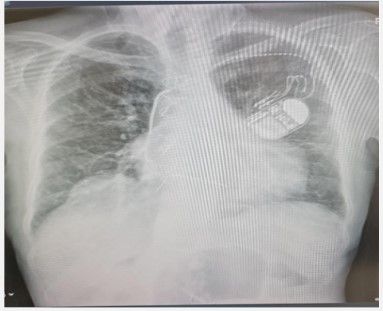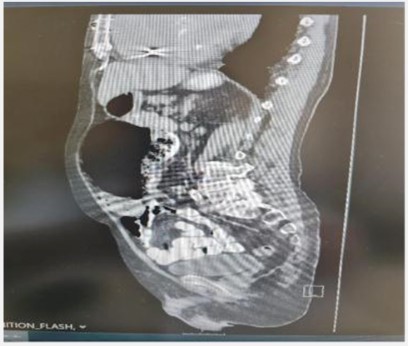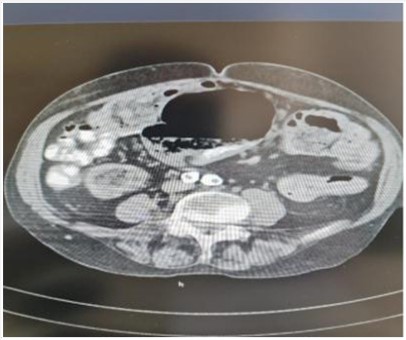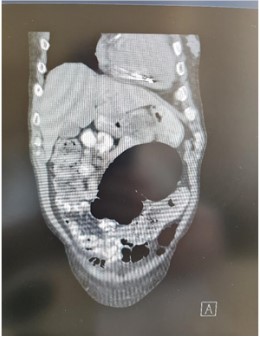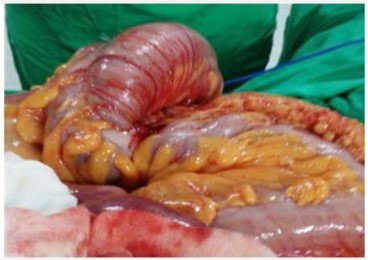Case Series
Volume 2, Issue 6
Cecal Bascule-An Unusual Cause of Intestinal Obstruction. 2 Unique Case Reports with Different Outcome
D Hazan1*; D Shamir2; K Dayan1
1Department of Surgery, the Edith Wolfson Medical Center, Holon, Israel affiliated with Sackler Faculty of Medicine, Tel Aviv
University, Tel Aviv, Israel.
2Department of Health Maintenance Organization of Clallit, Tel Aviv, Israel.
Corresponding Author :
Hazan Danny
Tel: 972-3-5028329; & 972-3-5028503
Email: dannyhazan2003@yahoo.com
Received : May 12, 2023 Accepted : Jun 06, 2023 Published : Jun 13, 2023 Archived : www.meddiscoveries.org
Citation: Hazan D, Shamir D, Dayan K. Cecal Bascule-An Unusual Cause of Intestinal Obstruction. 2 Unique Case Reports with Different Outcome. Med Discoveries. 2023; 2(6): 1044.
Copyright: © 2023 Hazan D. This is an open access article distributed under the Creative Commons Attribution License, which permits unrestricted use, distribution, and reproduction in any medium, provided the original work is properly cited.
Abstract
Objective: A cecal bascule is a rare type of cecal volvulus occurring in the elderly population with a male predominance. It is a condition where the cecum folds upward upon itself. There are only a handful of case reports published on a cecal bascule. This is the first case being reported from Israel.
Case presentation: This case discusses a 73 year old male with hypertension, ischemic heart disease, diabetes mellitus, chronic renal failure, and osteoporosis. He presented to the ED with complaints of vomiting, abdominal distension and absolute constipation with right lower quadrant pain. Radiology showed cecal bascule with suspected volvulus and showed cecal distention with air on the left side of abdomen. He was treated with an urgent right hemicolectomy with an anastomosis. Post-operatively, she developed ileus for which was treated, and on the 4th day, she spiraled into severe renal failure. On Day 8, he escalated into severe sepsis for which CT scan showed as a collection of fluid in his pelvis. He was managed with re-operation and complete disruption of the anastomosis and underwent an end ileostomy with drainage. The patient was admitted to the ICU where he was treated with CRRT and with a high volume of noradrenaline for severe metabolic acidosis. On the 14th day, he had severe necrosis of abdominal wall which underwent surgical debridement. On the 17th day, his disease process culminated in the ICU with ventricular fibrillation and prolonged resuscitation. Unfortunately, the patient did not live through this unique diagnosis and progressive series of events.
A 48 year old female known hypertensive and osteoporosis presented in the ER with complaints of vomiting, abdominal distension and constipation. Radiology was non-diagnostic. She was admitted to our department where she underwent a colonoscopy with a suspected cecal bascule. She was treated with a cecectomy and an anastomosis. Post operatively, she developed ileus, for which was managed. She was subsequently discharged on the 8th day post-op.
Discussion: Cecal bascule is difficult to diagnose and sometimes misdiagnosed as recurrent appendicitis until a severe attack ensues. The management of cecal bascule is always surgery with predilection towards eithercecopexy, cecetomy, or a right hemicolectomy to prevent recurrence and to give definitive treatment.
Conclusion: Cecal bascule is a rarity in surgical patients. Due to its non-specific radiological features, it may go undiagnosed.
Keywords: Cecal bascule; Appendicitis; Managements.
Introduction
Cecal volvulus has been a well-defined term since the 1830s [1,2]. It is caused by the axial rotation of the cecum, distal ileum and proximal colon, usually presenting in individuals who do not have normal cecal fixation [3]. A rare type of cecal volvulus is the cecal bascule in which the cecum may fold upward and anteriorly upon itself without an axial twist [3-5]. The Cecal bascule has an incidence of 2.8-7.1 per million people per year, and makes up only 1-2% of all large bowel obstructions [6]. There are only a handful of case reports about the cecal bascule. Here, we present two unique cases with different outcomes.
Case presentation
A 73 year old male, known hypertensive with ischemic heart disease, diabetes mellitu, chronic renal failure, and osteoporosis presented in the ER with complaints of vomiting, abdominal distension and absolute constipation with right lower quadrant pain. On examination, the abdomen was tense, tympanatic and mildly tender on the right side upon deep palpation. Radiology was non-diagnostic. His X-ray of his abdomen supine with chest shown below (Figure 1). Demonstrated dilated small bowel and cecal distension with fecal loading and no gas under the diaphragm. Based on radiological evidence, no proper cause of intestinal obstruction could be identified. The patient then underwent a CT scan (Figures 2 and 3) in which radiology showed a cecal bascule with suspected volvulus with cecal distention with air on the left side of the abdomen. He was treated with an urgent right hemicolectomy and anastomosis. Post operatively, she developed ileus for which she was treated. On the 4th day, she developed severe renal failure. Later on the 8th day, she developed severe sepsis which CT scan show collection of fluid in his pelvic which was managed with re-operation. This included complete disruption of anastomosis and end ileostomy with drainage. The patient was admitted to the ICU where he was then treated with CRRT and a high volume of noradrenaline because of severe metabolic acidosis. On the 14th day, severe necrosis of abdominal wall was found which underwend surgical debridement. On the 17th day in the ICU, he developed ventricular fibrillation with prolonged resuscitation and in the end, deceased. On pathological examination showed a volvulus of the right colon with severe congestion of blood vessels with four reactive lymph nodes and viable surgical margins.
A 48 year old female, known hypertensive presented in the ER with complaints of vomiting, abdominal distension, and constipation. Apart from an uneventful caesarian section 5 years prior, she had no other past surgical history. She had history for similar complaints one year back, for which she was managed conservatively. On examination, the abdomen was tense, tympanatic, and mildly tender on the right side upon deep palpation. Radiology was non-diagnostic with her X-ray of her abdomen supine shown below (Figure 4). It demonstrated dilated small bowel and cecal distension with fecal loading and no gas under the diaphragm, which could be seen in the chest x-ray (Figure 5). Based on radiology, no proper cause of intestinal obstruction could be identified. She was admitted to our department which she underwent colonoscopy with suspected cecal bascule. Surgery was performed by the consultant surgeon and senior registrar. The patient was counselled for right hemicolectomy, diversion and stoma formation but on laparotomy, around 200 ml reactionary fluid was aspirated. Both the cecum and the small bowel were distended but healthy looking. The cecum was found rotated anteriorly upon itself (Figure 6). Distal to the caecum, the large bowel was collapsed. There was no other obvious pathology observed. The liver and peritoneum were normal. A cecectomy was done with end to end ileo-colic anastomosis. Post operatively, she developed ileus for which was managed. She was subsequently discharged on the 8th day post op. the patient was called for follow-up after two weeks in which she reported uneventful post discharge recovery.
Discussion
The cecal bascule is a rare form of a cecal volvulus in which the cecum folds anteriorly instead of twisting upon its axis [6]. This results in a deep crease which acts as a functional transit point. Due to a competent ileocecal valve, this becomes a closed-loop and confines distension only to the cecum [7]. The development of a cecal bascule is dependent upon the hypermobility of the cecum [8]. It has been reported that adhesions formed may fix the anterior cecal wall to the anterior wall of the ascending colon leading to a cecal bascule [9,10]. This may occur, for example, after a surgical procedure, such as a Laparoscopic cholecystectomy [6], a laparoscopic hernia repair [11], a laparoscopic gastric bypass or a pelvic surgery, such as a total abdominal hysterectomy [12,13]. It has also been reported in a child who has had a Nissen fundoplication [7]. Another hypothesis states that changes in the patient position during surgeries from reverse Tendelenburg to a horizontal plane may allow a hypermobile cecum to fold anteriorly and obstruct the large bowel causing a cecal bascule [7]. It is agreed upon that for the development of cecal bascule, the presence of a competent ileocecal valve is required regardless of the accompanying adhesions [5,13]. The term embryogenic mobile cecum is used to define a congenital mal-fixation of the cecum to the right iliac fossa. This is due to a long mesentery which is fixed to the retroperitoneum by a narrow base of origin or the inability of the right colonic mesentery to fuse to the peritoneum [6]. The Cecal bascule is difficult to diagnose and maybe misdiagnosed as recurrent appendicitis until a severe attack ensues [14]. Unlike the “coffee bean” sign which occurs in a sigmoid volvulus, there is no pathognomic sign for a cecal bascule on a plain x-ray, resulting in an interpretation of non-specific, abnormal gas pattern [7]. A CT may clearly define the large bowel anatomy, but in our case, it was non-diagnostic.
The treatment of choice for a ceacal bascule is surgery. Simple reduction can lead to recurrence, and hence cecopexy or resection and anastomosis should be the preferred approach [7].
Conclusion
To reiterate, a Cecal bascule is a rarity in surgical patients. Due to its non-specific radiology, it may go undiagnosed. A CT scan may or may not prove to be a useful modality. In patients who have undergone surgery before, this diagnosis should be placed in the differential.
Surgical aims should be to prevent recurrence. Cecopexy or resection should be prioritized.
Author's contributions: Danny Hazan- Idea and writing, Dana Shamir- tables, Katya Dayan- review, Kevin Somer- review.
References
- RA Agha, T Franchi, C Sohrabi, G Mathew. For the SCARE Group. The SCARE 2020 guideline: updating consensus Surgical Case Report (SCARE) guidelines Int. J. Surg. 2020; 84: 226-230.
- M. Weinstein. Volvulus of the cecum and ascending colon Ann. Surg. 1938; 107: 248.
- R Rabinovici, DA Simansky, O Kaplan, E Mavor, J Manny. Cecal volvulus Dis. Colon Rectum. 1990; 33: 765-769.
- E Delabrousse, P Sarlieve, N Sailley, S Aubry, BA Kastler Cecal volvulus: CT findings and correlation with pathophysiology Emerg. Radiol. 2007; 14: 411-415.
- M Chinoy, CV Reyes Cecal bascule Arch. Surg. 1984; 119.
- L Ferguson, Z Higgs, S Brown, D McCarter, C McKay. Intestinal volvulus following laparoscopic surgery: A literature review and case report J. Laparoendosc. Adv. Surg. Tech. 2008; 18: 405-410.
- DA Lazar, SA Cohen, DK Evora, BE Losasso, SW Bickler. Cecal bascule in a child: An unusual cause of postoperative bowel obstruction J. Pediatr. Surg. 2012; 47: 609-611.
- LM Bobroff, NH Messinger, K Subbarao, TC Beneventano The cecal bascule, Am. J. Roentgenol. 1972; 115: 249-252.
- BE Lung, SB Yelika, AS Murthy, M Gachabayov, P Denoya. Cecal bascule: A systematic review of the literature Tech. Coloproctol. 2018; 22: 75-80.
- AR de la Hermosa, P Ortega-Domene, ML Fuenmayor-Valera, A Perez-Morera, JB Seoane-González. Caecal bascule, an unusual cause of intestinal obstructionCirugía y Cirujanos (English Edition). 2016; 84: 513-517.
- J Kim, S Nguyen, P Leung, C Divino. Cecal bascule after laparoscopic ventral hernia repair JSLS J. Soc. Laparoendosc. Surg. 2013; 17: 484.
- S Upreti, CM Musara. Cecal bascule or “seesaw cecum”: A late complication of gastric bypass surgery: 295Am. Coll. Gastroenterol. 2015; 110:128-129.
- MC Veigel, G Dhillon, KJ Andresen. Multimodality imaging of cecal bascule: Report of a case following pelvic surgery Clin. J. Gastroenterol. 2012; 5: 225-229.
- JL Donhauser, S Atwell. Volvulus of the cecum: With a review of one hundred cases in the literature and a report of six new cases Arch. Surg. 1949; 58: 129-148.

